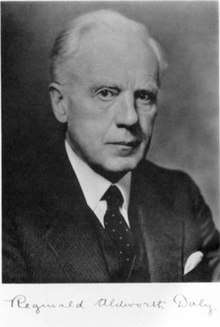Reginald Aldworth Daly
| Reginald Aldworth Daly | |
|---|---|
 | |
| Born |
March 18, 1871 Napanee, Ontario |
| Died |
September 19, 1957 (aged 86) Cambridge, Massachusetts |
| Nationality | Canadian |
| Alma mater |
Victoria University, Toronto (B.A., 1891; S.B., 1892) Harvard University (Ph.D., 1896) |
| Awards |
Hayden Memorial Geological Award (1932) Penrose Medal (1935) Wollaston Medal (1942) William Bowie Medal (1946) |
| Scientific career | |
| Fields | geology |
| Institutions |
Harvard University Massachusetts Institute of Technology |
| Doctoral advisor | John E. Wolff |
Reginald Aldworth Daly (March 18, 1871 – September 19, 1957) was a Canadian geologist.
Biography
He was educated at the University of Toronto, where geologist A.P. Coleman persuaded him away from teaching mathematics and into Earth Sciences. He attained his PhD at Harvard, and did postgraduate work in Germany and France. After working as a field geologist for the International Boundary Commission, he was a professor, and headed the Department of Geology at Harvard University from 1912 until 1942. Daly was president of The Geological Society of America in 1932.[1]
For the Boundary Commission, working in six field seasons, Daly mapped the border from the Pacific Ocean to the Great Plains, a rugged swath 400 miles (640 km) long and 5 to 10 miles (8.0 to 16.1 km) wide – an area of about 2,500 square miles (6,500 km2). He documented the geology alone, but had the help of one field assistant and numerous wranglers and porters. He collected 1,500 rock specimens and made 960 thin sections, using a German polishing technique he learnt as a student. The project also included 1,300 photographs, dozens of lake soundings, stratigraphic and structural mapping, petrology, and morphology.[2] In 1912, he filed his final report with the Geological Survey of Canada, a massive 3-volume tome he called North America Cordillera: Forty-Ninth Parallel.[3] This work along the 49th parallel led him to formulate a theory of the origins of igneous rocks, and later publish his seminal work Igneous Rocks and Their Origin in 1914.
According to Daly's biographer, James Natland, Daly was an early proponent of Arthur Holmes' and Alfred Wegener's continental drift theory.[4] Daly summarized his ideas in his 1926 book, Our Mobile Earth, which included on the title page small print adopted from Galileo: E pur si muove. Daly's theory on continental displacement was based partly on the idea that after the Moon was ejected from the Earth, continental movement was an inevitable part of rebalancing the planet; he also suggested that continental material accruing near oceans eventually slips, and forces continents to creep along. He expanded this notion in Strength and Structure of the Earth, in 1940, where Daly anticipated aspects of plate tectonics, including introduction of a "mesospheric shell" and a slippery vitreous basaltic substratum.
Daly also proposed the impact theory of lunar creation in 1946, which countered two prevailing notions: George Darwin's hypothesis that the Moon spun out of the primordial Earth due to centrifugal force; and, another fashionable theory that the Moon was a captured wayward asteroid. Daly applied Newtonian physics to make his point, which was later validated.
Daly was awarded the Penrose Medal in 1935, the Wollaston Medal in 1942[5] and the William Bowie Medal in 1946. In 1950 he became foreign member of the Royal Netherlands Academy of Arts and Sciences.[6] The mineral dalyite[7] and craters on Mars and the Moon are named in his honor. His Cambridge, Massachusetts, house (the Reginald A. Daly House) is now a National Historic Landmark.
References
- ↑ Eckel, Edwin, 1982, GSA Memoir 155, The Geological Society of America — Life History of a Learned Society: Boulder, Colorado, Geological Society of America Memoir 155, 168 p., ISBN 0-8137-1155-X.
- ↑ Miksha, Ron (2013). The Mountain Mystery, p. 322.
- ↑ Daly, R.A., (1912). Geology of the North American Cordillera at the 49th Parallel, Ottawa, Government Printing Office, Canada Department of Mines Geological Survey Memoir 38.
- ↑ Natland, James (2006). "Reginald Aldworth Daly (1871–1957): Eclectic Theoretician of the Earth," Geology Today, pp. 24-26, Geological Society of America.
- ↑ "Wollaston Medal". Award Winners since 1831. Geological Society of London. Archived from the original on 2010-08-19. Retrieved 2009-02-25.
- ↑ "Reginald Aldworth Daly (1871 - 1957)". Royal Netherlands Academy of Arts and Sciences. Retrieved 19 July 2015.
- ↑ Dalyite
Bibliography
- Daly, R A (1940), "Strength and Structure of the Earth", Prentice-Hall, New York, p. 434, ISBN 978-0028435206
- Daly, RA (1933), "The Depths of the Earth", Science (published Jan 27, 1933), 77 (1987): 95–102, Bibcode:1933Sci....77...95D, doi:10.1126/science.77.1987.95, PMID 17797838
- Daly, RA (1931), "Gardiner on Coral Reefs", Science (published Dec 4, 1931), 74 (1927): 566–567, Bibcode:1931Sci....74..566D, doi:10.1126/science.74.1927.566, PMID 17807633
- Daly, R A (1920), "A General Sinking of Sea-Level in Recent Time", Proc. Natl. Acad. Sci. U.S.A. (published May 1920), 6 (5), pp. 246–50, Bibcode:1920PNAS....6..246D, doi:10.1073/pnas.6.5.246, PMC 1084496, PMID 16586806
- Daly, R A (1917), "Low-Temperature Formation of Alkaline Feldspars in Limestones", Proc. Natl. Acad. Sci. U.S.A. (published Nov 1917), 3 (11), pp. 659–65, Bibcode:1917PNAS....3..659D, doi:10.1073/pnas.3.11.659, PMC 1091350, PMID 16576265
- Daly, R A (1916), "A New Test of the Subsidence Theory of Coral Reefs", Proc. Natl. Acad. Sci. U.S.A. (published Dec 1916), 2 (12), pp. 664–70, Bibcode:1916PNAS....2..664D, doi:10.1073/pnas.2.12.664, PMC 1091132, PMID 16586654
- Daly, RA (1901), "Notes on Oceanography", Science (published Jun 14, 1901), 13 (337), pp. 951–954, Bibcode:1901Sci....13..951D, doi:10.1126/science.13.337.951, PMID 17733661
- Daly, RA (1901), "Scientific Expedition to Iceland, Greenland and Labrador", Science (published Feb 1, 1901), 13 (318): 192, Bibcode:1901Sci....13R.192D, doi:10.1126/science.13.318.192, PMID 17816318
Further reading
Mather, Kirtley (1970–80). "Daly, Reginald Aldworth". Dictionary of Scientific Biography. 3. New York: Charles Scribner's Sons. pp. 547–548. ISBN 978-0-684-10114-9.
- Robert M. Hazen: Reginald Aldworth Daly (1871-1957). Daly′s Biography, American Geophysical Union
- James H. Natland: Reginald Aldworth Daly (1871–1957): Eclectic Theoretician of the Earth. GSA Today, vol. 16, no. 2, 2006
- Francis Birch: Reginald Aldworth Daly, 1871-1957, A Biographical Memoir National Academy of Sciences, Washington, DC, 36 pp., 1960